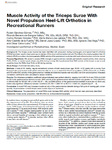| dc.contributor.author | Becerro-de-Bengoa-Vallejo, Ricardo | |
| dc.contributor.author | Romero Morales, Carlos | |
| dc.contributor.author | Castrillo de la Fuente, Aitor | |
| dc.contributor.author | Díez Vega, Ignacio | |
| dc.contributor.author | Calvo-Lobo, César | |
| dc.contributor.author | López-López, Daniel | |
| dc.contributor.author | Sánchez Gómez, Rubén | |
| dc.contributor.author | Losa Iglesias, Marta Elena | |
| dc.date.accessioned | 2020-11-24T11:10:41Z | |
| dc.date.available | 2020-11-24T11:10:41Z | |
| dc.date.issued | 2020 | |
| dc.identifier.citation | Sánchez-Gómez R, Becerro-de-Bengoa-Vallejo R, Romero Morales C, Losa-Iglesias MA, Castrillo de la Fuente A, López-López D, Díez Vega I, Calvo-Lobo C. Muscle Activity of the Triceps Surae With Novel Propulsion Heel-Lift Orthotics in Recreational Runners. Orthop. J. Sports Med. 2020; 8(10) | es_ES |
| dc.identifier.issn | 2325-9671 | |
| dc.identifier.uri | http://hdl.handle.net/2183/26751 | |
| dc.description.abstract | [Abstract] Background:The triceps surae muscle has been identified with propulsion during running gait, and typical heel-lift orthotics
(THOs) have been used to treat some sports injuries of this structural-biomechanical unit. The effects of a novel propulsion heel-lift
orthotic (PHO) on surface electromyography (EMG) activity of the gastrocnemius during a full cycle of running have yet to be tested.
Purpose/Hypothesis:We aimed to assess EMG changes in gastrocnemius medialis and lateralis muscle activity when wearing
THOs, PHOs, or neutral sports shoes only (SO) during running. We hypothesized that EMG activity of the triceps surae muscle
would be lower for PHOs than THOs or SO during running.
Study Design:Controlled laboratory study.
Methods: A total of 26 healthy, regular recreational runners of both sexes (mean age, 33.58±6.02 years) with a neutral Foot
Posture Index and rearfoot strike pattern were recruited to run on a treadmill at 9 km/h using aleatory THOs of 6 and 9 mm, PHOs,
and SO while EMG activity of the gastrocnemius medialis and lateralis muscles was recorded over a 30-second period. Intraclass
correlation coefficients were calculated to assess reliability.
Results:The intraclass correlation coefficient values indicated near perfect reliability, ranging from 0.801 for 6-mm THOs to 0.959
for SO in the gastrocnemius lateralis muscle. EMG activity of the gastrocnemius lateralis muscle was greater for PHOs (25.516±
4.780 mV) than for SO (23.140±4.150 mV) (P<.05), but EMG activity of the gastrocnemius medialis muscle did not show any
statistically significant difference between conditions (23.130±2.980 mV vs 26.315±2.930 mV, respectively) (P¼.3).
Conclusion:A novel PHO may increase muscle activity of the gastrocnemius lateralis during a full cycle of running gait; consequently,
its prescription to treat triceps surae muscle injuries is cautioned.
Clinical Relevance:The prescription of novel PHOs could increase EMG activity, which has not been previously described | es_ES |
| dc.language.iso | eng | es_ES |
| dc.publisher | SAGE Publications Ltd | es_ES |
| dc.relation.uri | https://doi.org/10.1177/2325967120956914 | es_ES |
| dc.rights | Atribución-NoComercial-SinDerivadas 4.0 España | es_ES |
| dc.rights.uri | http://creativecommons.org/licenses/by-nc-nd/4.0/es/ | * |
| dc.subject | Triceps surae | es_ES |
| dc.subject | Propulsion | es_ES |
| dc.subject | Heel-lift orthotics | es_ES |
| dc.subject | Surface electromyography | es_ES |
| dc.subject | Triceps sural | es_ES |
| dc.subject | Propulsión | es_ES |
| dc.subject | Talón | es_ES |
| dc.subject | Electromiografía | es_ES |
| dc.title | Muscle Activity of the Triceps Surae With Novel Propulsion Heel-Lift Orthotics in Recreational Runners | es_ES |
| dc.type | info:eu-repo/semantics/article | es_ES |
| dc.rights.access | info:eu-repo/semantics/openAccess | es_ES |
| UDC.journalTitle | The Orthopaedic Journal of Sports Medicine | es_ES |
| UDC.volume | 8 | es_ES |
| UDC.issue | 10 | es_ES |






